Khrueng Sai – The Thai String Ensemble
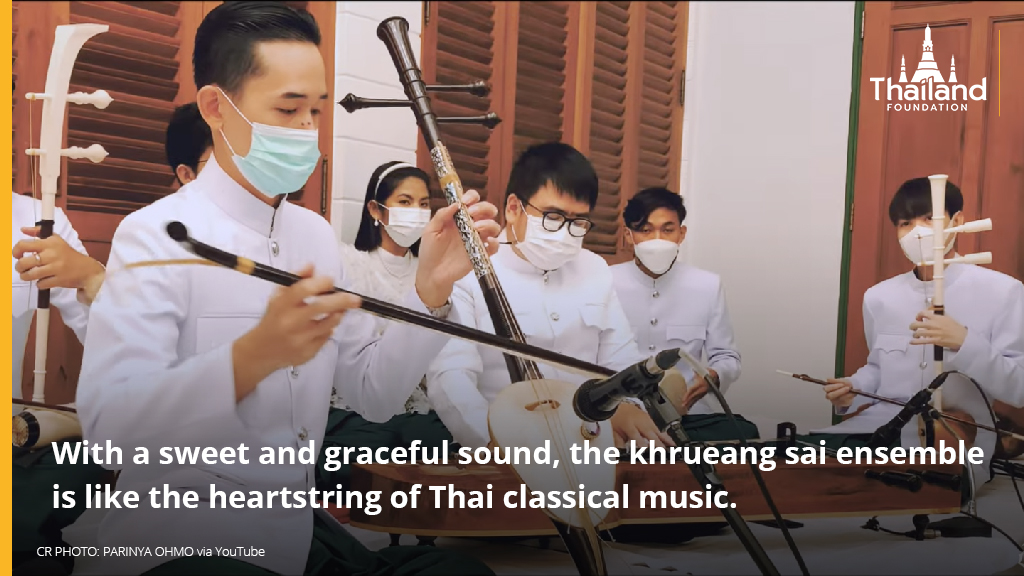
Wong khrueng sai (วงเครื่องสาย) or the Thai string ensemble is a Thai classical music ensemble with a very narrow yet unique melodic range, it mainly consists of string, plucked along with woodwind instruments accompanied by wooden percussions. These instruments produce a kind of soft, slow sustained sound, perfect for creating a joyful atmosphere.
Wong khrueng sai is usually performed in festive occasion and auspicious indoor ceremonies such as weddings and housewarming parties.
History
The origin of wong khrueng sai is still unknown but some resources said that it could be dated back to the early Ayutthaya period (1350-1448) since string instruments were already mentioned in Thai legal document by then. However, according to the historian Prince Damrong Rajanubhab, major Thai string instruments were performed solo rather than in an ensemble. It was not until the reign of King Rama IV reign (1851-1868) where the forming of the ensemble began. Influenced by Chinese string ensemble, people began mixing major Thai string instruments, such as saw u (ซออู้) – Thai alto fiddles and saw duang (ซอด้วง) – Thai soprano fiddle, into an organized ensemble. Later, during the reign of King Rama VI (1910-1925) more instruments such as khim (ขิม) or hammered dulcimer, violins, and wooden organ were added to the band, forming a new kind of string ensemble called wong khrueng sai phasom or the combined string ensemble.

(Photo Credit: Saisaw)
Types of Wong khrueng sai
The categories of wong khruneg sai is performed in different manners on different occasions depending on the instruments’ types, sound, and the atmosphere they create.
- Wong khrueng sai (วงเครื่องสาย) – classical Thai string ensemble is usually performed in indoor auspicious events, some called it “chamber ensemble”. They can be subcategorized into the small Thai string ensemble and the Thai double string ensemble.
-
- Wong khrueng sai diew (วงเครื่องสายเดี่ยว)– small string ensemble consists of one string instrument and one woodwind instrument. The instruments are
- one chake (จะเข้) or Thai zither
- one saw u (ซออู้) or Thai alto fiddle
- one saw duang (ซอด้วง) or Thai soprano fiddle
- one khlui phiang aw (ขลุ่ยเพียงออ) or Thai flute
- one set of thone and ramana (โทน รำมะนา) or a Thai hand and barrel drums
- one pair of ching (ฉิ่ง) or bronze cymbal castanets
- one pair of charb (ฉาบ) or cymbals
- one pair of krab (กรับ) or wooden rhythm clappers
- one mhong (โหม่ง) or gong
- Wong khrueng sai diew (วงเครื่องสายเดี่ยว)– small string ensemble consists of one string instrument and one woodwind instrument. The instruments are
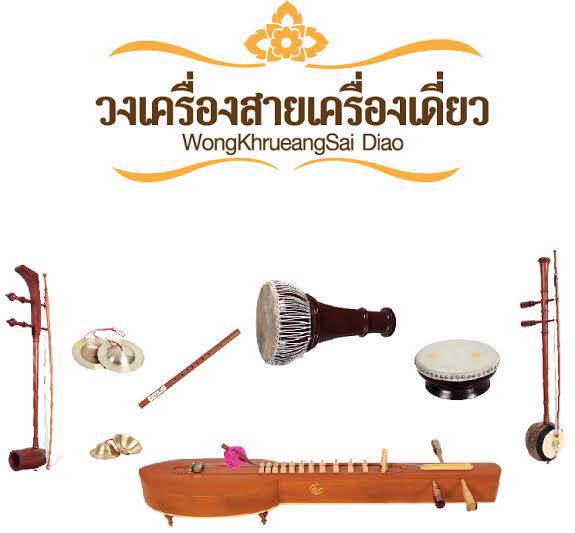
(Photo Credit: ครูทอมดนตรีไทย)
-
- Wong khrueng sai koo (วงเครื่องสายคู่) – double string ensemble consists of the small Thai string ensemble but with double amount the string instruments, as well as the addition of klui-lhip (ขลุ่ยหลีบ) or Thai soprano flute. The instruments are:
-
-
- two chake (จะเข้) or Thai zithers
- two sor-ou (ซออู้) or Thai alto fiddles
- two sor-duang (ซอด้วง) or Thai Soprano fiddles
- one khlui phiang oaw (ขลุ่ยเพียงออ) or Thai flute
- one khlui lhip (ขลุ่ยหลีบ) or Thai soprano flute
- one set of thone and ramana (โทน รำมะนา) or a Thai hand drum
- one pair of ching (ฉิ่ง) or bronze cymbal castanets
- one pair of charb (ฉาบ) or cymbals
- one pair of krab (กรับ) or wooden rhythm clappers and one mhong or kong)
-

(Photo Credit: สิทธิชัย สีหะวงษ์)
- Wong krueng sai phasom (วงเครื่องสายผสม) – combined string ensemble mainly consists of Thai string instruments with the addition of contemporary or other local instruments such as khim (ขิม) or hammered dulcimer, violins, wooden organ, piano, ranad (ระนาด) or wooden xylophone, kan (แคน) or reed mouth organ, accordion, saw sam sai (ซอสานสาย) or three-stringed fiddle The criteria for combining instruments depends on the synchronized harmony they produce when performing along with the original string ensemble.
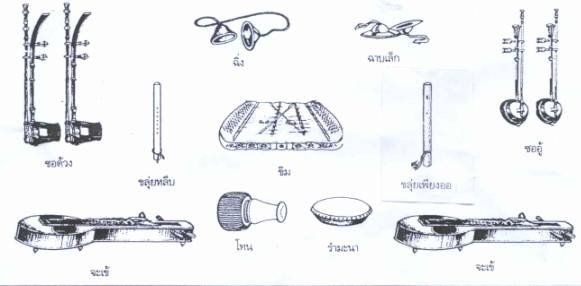
(Photo Credit: วงเครื่องสายผสม)
- Wong khrueng sai pi-java (วงเครื่องสายปี่ชวา) – small string ensemble with Javanese oboe – primarily consists of the fundamental string ensemble’s instruments. The khlui-phieng-or (ขลุ่ยเพียงออ) or Thai flute is, however, replaced with pi java (ปี่ชวา) or Javanese oboe, while the thone and rammana (โทน รำมะนา) is replaced with klong-khaek (กลองแขก) or double-headed barrel drums. The Pi-Java String Ensemble is further categorized into wong khrueng sai pi-java lek and the wong khrueng sai pi-java yai.
-
- Wong kroeung sai pi java wong lek (วงเครื่องสายปี่ชวาวงเล็ก) – small string ensemble with Javanese oboe. They consists of
-
-
- one pi Java (ปี่ชวา) or Java clarinet
- one khlui-lhip (ขลุ่ยหลีบ) or Thai flute
- one saw u (ซออู้) or Thai alto fiddle
- one saw duang (ซอด้วง) or Thai soprano fiddle
- one chake (จะเข้) or Thai zither
- klong khaek (กลองแขก) or double-headed barrel drums
- one pair of ching (ฉิ่ง) or bronze cymbals castanets.
- one krub (กรับ) or wooden rhythm clappers (optional)
- one mhong (โหม่ง)/ kong (ฆ้อง) or gong (optional)
-
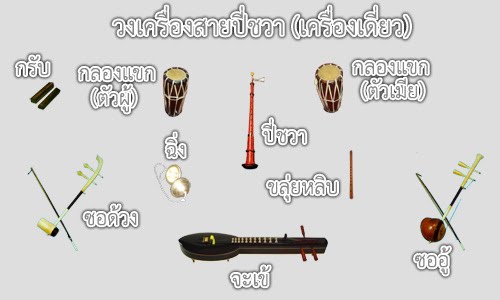
(Photo Credit: สิทธิชัย สีหะวงษ์)
-
- Wong khrueng sai pi-java wong yai (วงเครื่องสายปี่ชวาวงใหญ่) – Big Pi-Java Ensemble consists of the same instruments as the small Pi-Java Ensemble; however, the saw u (ซออู้), saw duang (ซอด้วง), and chakhe (จะเข้) are doubled.

(Photo Credit: สิทธิชัย สีหะวงษ์)
Wai Khru (ไหว้ครู): Paying Homage to Teachers
For every branch of Thai art, the ceremony of paying homage and respect to teachers, also known as the wai khru is widely practiced. Teachers, in traditional Thai beliefs, consist not only of living instructors, but also deceased masters, spirits, and even gods. The purpose of the wai khru ceremony is to establish a bond between teachers and students. Students demonstrate respect toward the teachers and honor the skills that have been passed down to them. Teachers, in return, bless and look after the students, guiding them down a righteous path.
Phra Panjasingkhorn or Pancasikha (พระปัญจสิงขร) is a celestial musician found in Buddhist lore who is said to be exceptionally adept in playing the lute. He worshipped as the deity of string instruments and has long been recognized as one of the three main deities of music. Musicians who play saw or Thai fiddles and other string instruments always pay homage to him before performance. Thus, Phra Panjasingkhorn is often worshipped as the patron deity of wong khrueng sai. His presence is often invoked during wai khru ceremony performed by wong khrueng sai musicians.
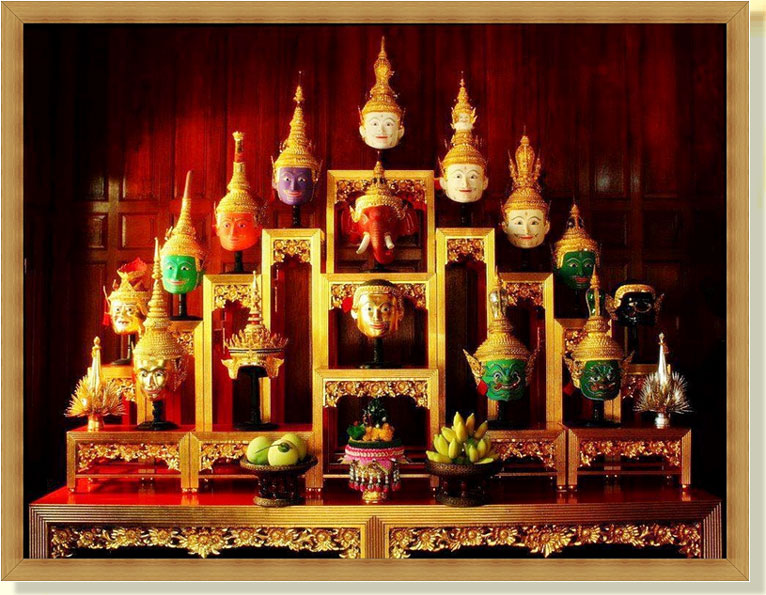
(Photo Credit: ประจักษ์ น้อยเหนื่อย)
Conlusion
Wong khrueng sai reflects the values and characteristics of the Thai people. First, it showcases that Thai musicians possess great artistic abilities. Playing in the band is not an easy task. Musicians must train for years to master each instrument. They must also be adept in conveying emotions through sound and understanding how the tunes of each instrument match together to create a collective euphony.
Second, the composition of wong khrueng sai reflects Thailand longstanding tradition of embracing other cultures. Rather than going the conservative route, wong khrueng sai has always been open to adopting new instruments and style into its composition, whether it be the Western piano or the Javanese-influenced pi java. With this openness, Thai musicians are able to explore new ways to create art.
Lastly, the rite of paying homage to teachers reflects the value of respect that is engrained in Thai culture. Thai musicians recognizes that their success in built upon the works of their predecessors. Respect, as demonstrated through the wai khru ceremony, creates a mutual relationship between masters and disciples. This allows for Thai musicians to further their art and skills into refreshing territories without succumbing to vanity and ungratefulness for those who came before them.
The story of “wong khrueng sai” is a classic facet of Thai culture and heritage. We saw how the essence of Thainess is represented through artistic finesse, respect, and openness. Join us in exploring more stories of Thailand and the Thai people, as we take you on a journey to discover Thainess.
Sources
- https://bit.ly/3LJK7sF
- https://www.stou.ac.th/study/sumrit/2-59(500)/page5-2-59(500).html
- https://sites.google.com/site/kheruxngdntrithai/prapheth-wng-dntri-thiy/wng-kheruxng-say
_________________________________________________________________________________________________________
Written by: Atikan Kulsakdinan
10 November 2022


